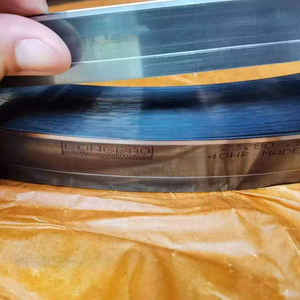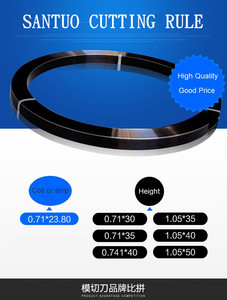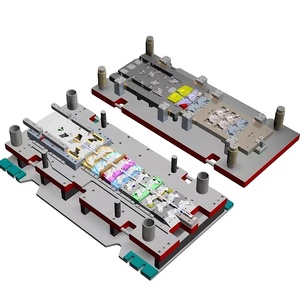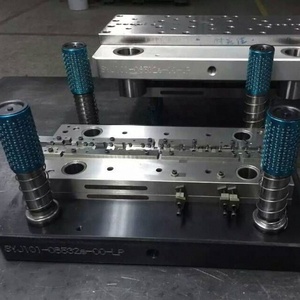
All categories
Featured selections
Trade Assurance
Buyer Central
Help Center
Get the app
Become a supplier

(5757 products available)

















































The materials used to make stamping die sets have a huge impact on the structural integrity and functionality of the die sets. The makers of these stamping die sets use a variety of materials depending on the nature of the die to be produced, be it progressive dies, compound dies, or even hammer dies. Stamping die set suppliers ensure that the die sets have the following materials:
Steel is the most commonly used material in making stamping dies because of its hardness and tensile strength. These two features make it possible for steel to tolerate the huge amount of pressure exerted during stamping operations without warping or giving in. The most prominent kinds of steel used are high-carbon steel, which is praised for its edge retention, and tool steel, which is renowned for its toughness and heat resistance.
As mentioned above, tool steel is one of the most popular materials used in making stamping dies because of its strength and durability. Material suppliers normally use alloyed tool steel, for instance, using tungsten, molybdenum, and vanadium, which all contribute to the die's ability to keep sharp edges for a long time. Such premium-quality tool steel is particularly useful in high-volume production settings where die wear can be a big problem.
Though not used as frequently as steel, aluminum provides a lightweight and cost-effective alternative for certain stamping applications. Aluminum dies are particularly used in processes that require less force, and the aluminum die is of course less wear out. Also, due to its lighter weight, it is better suited for jobs that require frequent die changes as this makes work easier and faster.
Copper alloys, especially bronze and brass, are used in stamping dies for non-ferrous metals. These materials have high thermal conductivity, which helps dissipate heat during stamping, preventing the material from sticking to the die. This characteristic makes copper alloys ideal for electrical component stamping dies, where precision and minimal friction are necessary.
Carbide is used in making dies to provide exceptional wear resistance, especially in high-production environments. In cases where dies undergo significant wear, such as in metal cutting dies or tire molds, carbide dies come in strongly with the lifespan of setting up the die offers easy maintenance. Although carbide dies are more expensive than other types, their longevity minimises the cost over time.
Customization options are present in stamping die set materials for virtually any and every product, as there are cases when the standard dies used are not adequate to cater to certain specific needs. This is favourable since customized dies enhance efficiency, precision, and overall product quality.
As elaborated earlier, materials for stamping die sets can be customized to enhance efficiency, precision, and overall product quality. High-carbon steel, tool steel, aluminum, copper alloys, and carbide might not be the best options unless specified when ordering. Material choice can be affected by the complexity of the die, volume, and materials being stamped.
Designing the die is also an important way of customization since certain aspects like shape, size, and details can be adjusted to meet certain specific requirements. Computer-Aided Design (CAD) software helps develop intricate designs that include provision for within cutouts and embossed patterns. This precision-in-design ensures that stamped products match the required specifications to a tee.
There are several ways die sets can be optimised for longer life or improved performance: coatings and treatments. Common coatings include titanium nitride and chromium, which keep the die from wearing out easily and sticking to the metal being stamped. Other thermal and chemical treatments, for example, hardening, be noted to improve die performance further.
Stamping die sets can be customized to fit into existing machinery in terms of interchangeability. In particular, Customization of this sort helps reduce downtime as well as installation hassles. Moreover, adjustable components are also fitted into the dies, allowing the die size or shape to be altered in order to accommodate varying tasks. This flexibility proves useful in dynamic production environments that frequently require changes in order to carry out different operations.
Die sets are used in making all sorts of complex shaped and functional metal parts in a variety of industries. Progressive die sets and home electric appliance die sets enable production to give an idea of how important these die sets are to mass manufacturing and product development.
The automotive industry is perhaps one of the largest consumers of stamping die sets. From car body partsto engine components,
the automotive sector relies on die sets to produce parts that possess the required strength and precision. Compound dies are used to shape metal sheets into doors, hoods, and chassis, etc. Such stamping processes are cost-effective, enabling high-volume production while maintaining quality.
Electronic devices are made of various metal components, which are often fabricated using stamping die sets. In this industry, dies enable the production of parts such as circuit boards, connectors, and casings. Due to the requirement of such electronic stamping components to be both accurate and consistent, indeed the high precision that comes with these die sets is a great advantage to mass production.
Another industry where stamping die sets are relevant is home appliance manufacturing. Basically, metal housings, frames, and internal components are produced through stamping processes. These die sets guarantee that parts have a high level of uniformity, which is indispensable in assembly and operations of appliances, be they washing machines or refrigerators.
Die sets are also used in the construction industry, especially in producing metal fasteners. Metal stamping dies create bolts, nuts, screws, and other vital hardware. Moreover, roofing materials and structural supports can also be produced via stamping. Hence, due to the diversity of the parts, durable and highly resistant die sets are required here.
The medical industry is in need of highly precise and reliable components, and this is what stamping die sets offer. Medical device manufacturers use these die sets to produce surgical instruments, implants, and diagnostic equipment components. In this application, the quality and accuracy of the die sets has a direct influence on product performance and patient safety, making them essential to this industry.
Different types of stamping dies are available, and each has specific characteristics that make them suited for certain operations and purposes. Knowledge of these different die types enablesindividuals to make ideal choices that meet the needs of these businesses and their clients.
Progressive dies are used in high-volume production to carry out complex stamping operations in one go. These are greatly useful in mass manufacturing, for they sequentially shape a single metal strip into a finished part. In industries like automotive, where large quantities are a must, progressive dies are invaluable because of this specific quality they possess.
Compound dies perform multiple operations simultaneously, such as cutting and shaping, in just one stroke of the press. They are useful when the requirement is for efficiency without sacrificing precision. In many manufacturing plants, compound dies are perfect, as they simplify the stamping process by reducing the number of required operations.
Also called simple die sets, single-action dies are the basic types of stamping dies that are widely used, especially in their early days. They are however used for basic cutting or shaping operations. Although they are not highly mechanised in their operations, they still have a big use in small production runs or in tasks that don't need complicated die work.
Production of thin materials is commonly carried out with the aid of hammer dies. They are mainly used in antique equipment manufacturing. The pressure is evenly distributed through the die, making it possible to shape without warping the material. Therefore, such dies are perfect for intricate designs.
Transfer dies, very much like progressive dies, are used in operations that require moving the material from one die to another. These dies are specifically applied in cases where the part shape needs frequent modifications during the stamping process. Such flexibility benefits complex assemblies in the production arena.
A1: The stamping die set would have to be customized based on the material to be stamped, the volume of production, and the required part complexity.
A2: High-density materials are ideal because they will resist the pressure concentration during the shaping of the metal elements.
A3: Compound die sets and progressive die sets are the most common stamping die sets used in the automobile industry.
A4: The dies used in metal furniture, such as metal stools, are usually designed for light and simple work, such as cutting and bending.
A5: There are specific dies, such as hammer dies and transfer dies, that are suitable for complicated die shapes and design.